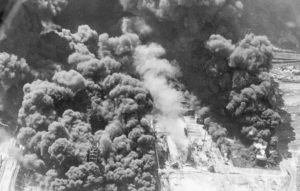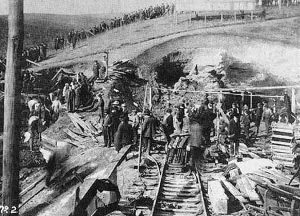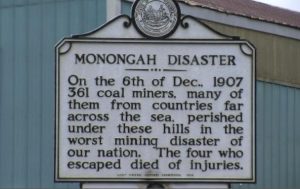ventilation
 Coal mining, especially underground coal mining can be a dangerous occupation. No matter how hard the safety coordinators tried to keep people safe, and no matter how stringent the safety regulations were, accidents happened and sometimes, lives were lost. Coal mining was especially dangerous when coal dust ignited. Explosions were the main cause of death in the mines,especially the underground mines. And that was just the instantaneous death. Breathing the dust caused a slow death over time. In 1883, the creation of the Norfolk and Western Railway opened a gateway to the untapped coalfields of southwestern West Virginia. New mining towns sprung up in the region practically overnight, with European immigrants and African Americans from the south pouring into southern West Virginia looking for work in the new industry. By the late 19th century, West Virginia was a national leader in the production of coal,but the state fell far behind other major coal-producing states in regulating the mining conditions. In addition to poor economic conditions, West Virginia had a higher mine death rate than any other state. Nationwide, a total of 3,242 Americans were killed in mine accidents in 1907, but no one accident could compare to the accident that was about to unfold as the year neared its end. No on was prepared for the horror that was to come in Monongah in December.
Coal mining, especially underground coal mining can be a dangerous occupation. No matter how hard the safety coordinators tried to keep people safe, and no matter how stringent the safety regulations were, accidents happened and sometimes, lives were lost. Coal mining was especially dangerous when coal dust ignited. Explosions were the main cause of death in the mines,especially the underground mines. And that was just the instantaneous death. Breathing the dust caused a slow death over time. In 1883, the creation of the Norfolk and Western Railway opened a gateway to the untapped coalfields of southwestern West Virginia. New mining towns sprung up in the region practically overnight, with European immigrants and African Americans from the south pouring into southern West Virginia looking for work in the new industry. By the late 19th century, West Virginia was a national leader in the production of coal,but the state fell far behind other major coal-producing states in regulating the mining conditions. In addition to poor economic conditions, West Virginia had a higher mine death rate than any other state. Nationwide, a total of 3,242 Americans were killed in mine accidents in 1907, but no one accident could compare to the accident that was about to unfold as the year neared its end. No on was prepared for the horror that was to come in Monongah in December.
The worst mining accident in United States occurred on December 6, 1907. The mine was the Monongah Coal  Mine in West Virginia’s Marion County. on that date, an explosion in a network of mines owned by the Fairmont Coal Company in Monongah killed 362 coal miners. Officially, there were 367 men in the two mines, but the actual number was much higher because officially registered workers often took their children and other relatives into the mine to help. No one thought of the practice as dangerous. At 10:28am an explosion occurred that killed most of the men inside the mine instantly. The blast went on to cause considerable damage to both the mine and the surface. The ventilation systems, necessary to keep fresh air supplied to the mine, were destroyed along with many rail cars and other equipment. The explosion blew the timbers supporting the roof down causing further issues when the roof collapsed. Investigators believed that an electrical spark or one of the miners’ open flame lamps ignited coal dust or methane gas, but the cause of the explosion was not determined.
Mine in West Virginia’s Marion County. on that date, an explosion in a network of mines owned by the Fairmont Coal Company in Monongah killed 362 coal miners. Officially, there were 367 men in the two mines, but the actual number was much higher because officially registered workers often took their children and other relatives into the mine to help. No one thought of the practice as dangerous. At 10:28am an explosion occurred that killed most of the men inside the mine instantly. The blast went on to cause considerable damage to both the mine and the surface. The ventilation systems, necessary to keep fresh air supplied to the mine, were destroyed along with many rail cars and other equipment. The explosion blew the timbers supporting the roof down causing further issues when the roof collapsed. Investigators believed that an electrical spark or one of the miners’ open flame lamps ignited coal dust or methane gas, but the cause of the explosion was not determined.
Time was of the essence to bring people out of a mine accident alive, because at that time they didn’t know much about restoring the air supply to the people trapped below. The first volunteer rescuers entered the two mines 25 minutes after the initial explosion. The biggest threats to rescuers are the various fumes, particularly “blackdamp”, a mix of carbon dioxide and nitrogen that contains no oxygen, and “whitedamp”, which is carbon monoxide. The lack of breathing apparatus at the time made venturing into these areas impossible. Rescuers could only stay in the mine for 15 minutes at a time. In a vain effort to protect themselves, some of the miners  tried to cover their faces with jackets or other pieces of cloth. While this may filter out particulate matter, it would not protect the miners in an oxygen-free environment. The toxic fume problems were compounded by the infrastructural damage caused by the initial explosion…mines require large ventilation fans to prevent toxic gas buildup, and the explosion at Monongah had destroyed all of the ventilation equipment. The inability to clear the mine of gases transformed the rescue effort into a recovery effort. One Polish miner was rescued and four Italian miners escaped. Following the accident, the United Mine Workers of America labor union and sympathetic legislators forced safety regulations that brought a steady decline in death rates in West Virginia and elsewhere.
tried to cover their faces with jackets or other pieces of cloth. While this may filter out particulate matter, it would not protect the miners in an oxygen-free environment. The toxic fume problems were compounded by the infrastructural damage caused by the initial explosion…mines require large ventilation fans to prevent toxic gas buildup, and the explosion at Monongah had destroyed all of the ventilation equipment. The inability to clear the mine of gases transformed the rescue effort into a recovery effort. One Polish miner was rescued and four Italian miners escaped. Following the accident, the United Mine Workers of America labor union and sympathetic legislators forced safety regulations that brought a steady decline in death rates in West Virginia and elsewhere.

